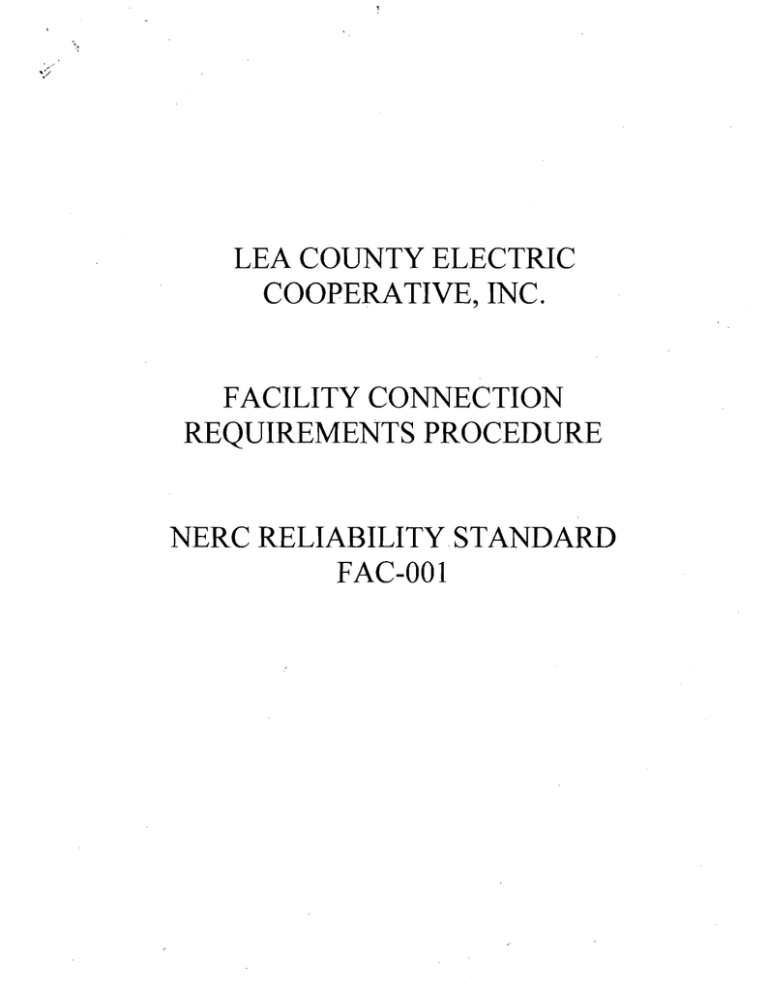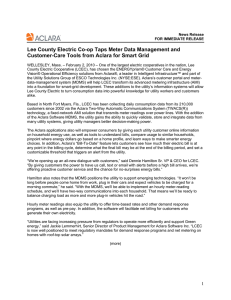to view the Facility Connection Requirements Procedure
advertisement

LEA COUNTY ELECTRIC COOPERATIVE, INC. FACILITY CONNECTION REQUIREMENTS PROCEDURE NERC RELIABILITY STANDARD FAC-OOI TABLE OF CONTENTS I. Introduction II. Definitions and Acronyms III. General Requirements Applicable to FAC-OOI IV. Specific Requirements Applicable to FAC-OOI V. Attachments Note: NERC Reliability Standard FAC-OO 1 Requirements are noted in bold italicized text at the corresponding LCEC Requirement in this document. 1. Introduction: The Lea County Electric Cooperative, Inc. (LCEC) FAC-OO 1 procedure provides details to the prospective transmission user to facilitate an understanding of the respective Facility Connection Requirements. These guidelines establish a consistent process for formatting and content of documents for LCEC Facility Connection Requirements for Generation Facilities, Transmission Facilities, and End-User Facilities as required by NERC Reliability Standard FAC-OOL A consistent approach in format and content of Facility Connection Requirement documents will aid prospective LCEC members in evaluating connection requirements. Because facility connections may vary, this guideline contains procedures that may not apply equally to all facility types. II. Definitions and Acronyms: Bulk Power System - As defined by the Regional Reliability Organization, the electrical generating resources, transmission lines, interconnections with neighboring systems, and associated equipment, generally operatedat 100 kV or higher. Distribution Provider - An entity that provides and operates the "wires" . between the transmission system and the end-use customer, whether at standard distribution voltages or at transmission voltages. End-User Facility - A facility owned or operated by an entity that purchases and uses electric service provided by a Distribution Provider or Load Serving Entity. Generation Facility - A facility that performs the function of supplying energy via interconnected operations. Harmonic Distortion - Distortion of the normal line waveform, generally transmitted by non-linear loads. Switch mode power supplies and . variable speed motors are examples of non-linear loads. KV - Kilovolt. 1000 volts of electric energy. KVA - Kilovolt-ampere. The amount of apparent power in an electric circuit, equal to the product of voltage and current, measured in volt­ amperes. One kilovolt-ampere is equal to 1000 volt-amperes. KVAR - Kilovolt Ampere Reactive. KVAR is the unit used to measure reactive power in an AC electric power system. KW - Kilowatt. 1000 watts of electric power. LCEC - Lea County Electric Cooperative LF - Load Factor. The percentage of the entity's peak demand for power that is used for the remaining time period "off-peak". Load Serving Entity - An entity that secures energy and transmission services to serve the electrical demand and energy requirements of its end use customers. NERC - North American Electric Reliability Corporation PF - Power Factor. The ratio of real power flowing to a load to the apparent power. Real power is measured in watts, apparent power is measured in volt-amperes, and reactive power is measured in reactive volt-amperes. Power factor is defined as (real power/apparent power) SCADA - Supervisory Control and Data Acquisition. System of devices that analyses and operates the power system from a remote location. SPP RE - Southwest Power Pool Reliability Entity Transmission Facility - A system of structures, wires, insulators and associated hardware that carries electric energy from one point to another in an electric power system. Transmission voltages vary from 69 kV up to 765 kV, and are capable of transmitting large quantities of electric energy over long distances. III. General Requirements: The parties shall perform all obligations of this agreement in accordance with all applicable laws and regulations, operating requirements and good utility practice. The interconnection customer shall construct, interconnect, operate and maintain its interconnection-facility in accordance with the applicable manufacturer's recommended installation procedures and maintenance schedules in accordance with this agreement, and good utility practice. The interconnection customer agrees to construct its facilities or systems in accordance with applicable specifications that meet or exceed those provided by the National Electrical Safety Code, American National Standards Institute, IEEE, Underwriters Laboratory and operating requirements in effect at the time of construction and other applicable national and state codes and standards. The generation, transmission or distribution provider (LCEC) shall construct, operate and maintain its generation, transmission and distribution system in accordance with this agreement and good utility practice. IV. Specific Requirements Applicable to FAC-OO 1 System Impact Study Procedures: Upon receipt of an executed system impact study agreement (Attachment I), LCEC will use due diligence to complete the required system impact study within a sixty (60) day period. The system impact study shall identify any transmission or distribution system constraints and additional direct assignment liabilities or upgrades required to provide the requested service (Attachment II).. In the event that LCEC is unable to complete the required system impact study within such time period, it shall notify the eligible customer and provide an estimated completion date. LCEC shall deliver the completed system impact study to the eligible customer once it has been completed. The eligible customer will have fifteen (15) days after receipt of the system impact study to notify LCEC if the study is acceptable. Attachment I . Lea County Electric System Impact Study Agreement This service agreement date as of , is entered into, by and between Lea County Electric Cooperative, Inc. and (customer) 1.0 - The generation, transmission, or distribution customer is requesting a transmission or distribution interconnection on the LCEC system. 2.0 - The generation, transmission, or distribution customer has agreed to provide, upon request, a deposit to LCEC for the system impact study as identified in this agreement. Any notice or request made to or by either party regarding this service agreement shall be made to the representation of the other party as indicated below. LCEC Customer In Witness Whereof, the parties have caused this Service Agreement to be executed by their respective authorized officials. Lea County Electric Cooperative, Inc. By _ Name Title Date Customer - - - - - - - - - - - - - - - - - By _ Name Title Date . Attachment II Specifications for Generation, Transmission, or Distribution Service 1.0 - Term of Transaction - - - - - - - - - - - - - - - Start Date - - - - - - - - - - - - - - - - - - - - Termination Date - - - - - - - - - - - - - - - - - - 2.0 - Description of capacity and energy requirements provided or required by customer including the site in the LCEC control area where the project is located. 3.0 - Points of Delivery: KW Demand Winter - - ­ Summer- - - - - ­ Energy Requirements or Sales Annually Delivery Voltage KV Annual Load Factor - - - - - - - ­ Interconnection Point Location of Interconnect (Provide Drawing) From: - - - - - - , - - - - - - - - - - - - - - - ­ To: - - - - - - - - - - - - - - - - - - ­ Delivery Point: Name of Receiving Entry . Point of Delivery Description Harmonic Distortion (per IEEE 519) _ _ _ Power Factor (must maintain 95% PF) Base Connected Load Factor % % % % Peak Month, monthly L.F. Average Annual L.F. Peak Demand- - - - - - ' - - ­ KW Annual Consumption -----­ Month KWH Upon completion of this study, specifications for such projects shall be communicated to the Balancing Authority within sixty (60) days for Generation and/or Transmission customers, and for Distribution projects deemed large enough to affect Bulk Power System operations. Explain Voltage and VAR Control at Deliver Point: Please provide the following information: • • • • • Fault Duty at Point of Delivery Automated Controls (SCADA) Bus Transfer Capability (one-line diagram) VAR Control (amps, voltage, temperature, P.F.) Provide Information. All communications frequencies (SCADA, 2-way radio, etc.) The following technical information shall be included in the system impact study application: Breaker duty and surge protection Design requirements that shall be addressed include: 1. Short circuit capabilities of current carrying elements 2. Ratings of interrupting devices 3. Existing and planned future fault current levels 4. Arrester application System protection and coordination design and operational requirements that shall be included: 1. Safety of general public 2. Prevention/minimization of equipment damage 3. Minimization of equipment outage time 4. Minimization of system outage area 5. Minimization of system voltage disturbances 6. Maintenance of protective system coverage for abnormal conditions 7. Performance of all appropriate studies: grounding, short circuit, stability, power quality and coordination of protective devices 8. Specifications of RTU protocols and other communication channels 9. Relay and.device coordination with existing system protection 1a.Generation - specific facility requirements that shall be addressed and information provided are: a) Synchronizing with the transmission or distribution system b) Parallel operation with the transmission or distribution system c) Protection against islanding Metering and Telecommunication. Typical metering data requirements shall include the following: KW KWH KVAR, leading and lagging KVAR-hour Voltage Metering and Communication Design requirements that shall be addressed include: • Loss Compensation • Bi-Directionally • Metering Accuracy • Ancillary equipment specification (e.g., C.T.s, P.T.s) • Provisions for Maintenance and Calibration • Data Protocols • Mode of data transmission (e.g. Fiber optic cable, phone line) Grounding and safety procedures that shall be included: 1. Voltage Unbalance 2. Voltage Flicker 3. Harmonic Distortion 4. Transient Overvoltage 5. Temporary Overvoltage 6. Temporary Undervoltage 7. Insulation Coordination 8. Operating Frequency 9. Power Factor Range 1a.Interruption/Outage Frequency The system impact study may identify additional equipment necessary to meet power quality standards. Equipment Ratings: Equipment rating shall be established and Communicated in accordance with the current approved version ofNERC Reliability Standards FAC-008 and FAC­ 009 or their successor. • Identification of general design parameters and practices of LCEC distribution or transmission shielding, attachment details, surge protections, current-carrying elements, basic insulation levels (BIL) • Provision of distribution or transmission owner review of facility design and specifications as they impact the reliability and operation of the system • Special requirements due to atmospheric, geological or environmental conditions • Responsibility for changes to existing distribution or transmission system made necessary by the project Synchronizing of facilities to the distribution or transmission system • The responsibility associated with synchronizing generation, transmission, and distribution facilities shall be agreed upon between the parties. • Synchronizing equipment • Test plans • Applicable reclosing requirements and prohibitions for generation, transmission and distribution facilities Maintenance coordination Operational requirements that shall be addressed include: Circuit breakers Generators Power transformers Protective relays Revenue metering Communications Trip circuits Interrupters Power DC sources Grounding system Distribution or transmission facilities The maintenance practices of the generation and/or transmission facility owner/operator and distribution user on their connected equipment shall be performed at a level that ensures the reliability and continuity of service of the interconnected system. Relevant maintenance records shall be provided to LCEC on an annual basis, or upon request if deemed necessary by LCEC, and shall include: • Definition of maintenance programs, responsibilities and performance :<.; " objectives • Authorization, notification and clearance for work t • Generation: Such planning shall take into account unit commitment obligations, replacement power and/or contractual obligations that impact the performance of the bulk power system • End-users: The maintenance practices of the end user on their connected equipment shall be performed at a level that ensures the reliability of the 'interconnected system Operational issues (abnormal frequency and voltage) • Documentation outlining procedures for abnormal voltage conditions • A procedure providing operation guidelines for frequency conditions • Procedure for generators connected through a tapped transmission line • Relay coordination to maintain stability • Load shedding implementations The operation issue shall be identified and included in the system impact study application, Inspection requirements for e~isting or new facilities. Initial inspections shall be conducted by the LCEC personnel at which time the owner of the facility shall provide all the test reports including any audit records related to an existing facility requiring NERC Standards Compliance. Communication and procedures during normal and emergency operating conditions. The owner of the facility shall provide the following information to LCEC: • Provision for a point of contact. The generation, transmission or end-user shall provide the primary and backup contact persons for communications with LCEC personneL These contact persons shall have the authority and ability to operate the facility according to the instructions of the appropriate operating entity. .: • The generation and transmission facility operators and end-users shall communicate with and shall cooperate with the appropriate operating entity to support the recovery efforts during emergency conditions. This shall include but may not be limited to: • • • • • • • Switching operations VAR support Adjustment in real or reactive generation net output Tripping of generating unites) Starting of generating unites) including black start units Implementation of emergency communication procedures Transmission facility restoration efforts Limitation of liability Each party's liability to the other party for any loss, cost, claim, injury, liability or expenses including reasonable attorney's fees relating to or arising from any act or omission in its performance of this agreement shall be limited to the amount of the direct damage actually incurred. In no event shall either party be liable to the other party for indirect special, consequential or punitive damages, except as authorized by this agreement. LCEC shall maintain and update these facility connection requirements as necessary. LCEC shall make documentation of these requirements available to transmission users, the SPP Reliability Entity, and NERC within five (5) days of the receipt of written request for such documentation. Revision Original document Updated Date 5/14/2010 8/9/2010 Comments Approved By Michael Sarkis Added in language Michael Sarkis as suggested by T. Ward, SPP, to bring into full compliance Sign.atu;-e M~)v­ 'JW ,-~



